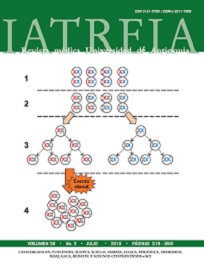Evaluación de conocimientos con exámenes de selección múltiple: ¿tres o cuatro opciones de respuesta? Experiencia con el examen de admisión a posgrados médico-quirúrgicos en la Universidad de Antioquia
DOI:
https://doi.org/10.17533/udea.iatreia.v28n3a08Palabras clave:
análisis de ítem, evaluación educacional, pruebas de selección múltipleResumen
Introducción: el objetivo de este estudio fue evaluar el efecto de la reducción del número de opciones de respuesta por pregunta sobre los indicadores sicométricos de un examen de ingreso a estudios médicos de posgrado.
Metodología: aplicación de índices de evaluación sicométrica desde la perspectiva de dos teorías: la clásica de la medición y la de respuesta al ítem, a una prueba de 70 preguntas hecha a 2.539 aspirantes a ingresar a los posgrados médico-quirúrgicos de la Universidad de Antioquia en el año 2014. Se eliminó la opción de respuesta elegida con menor frecuencia y se la reemplazó por azar de entre las tres restantes.
Resultados: solo 52,9% de las preguntas tuvieron tres opciones funcionales de respuesta. No se encontró diferencia en la dificultad, la discriminación, el error estándar de la medición, el alfa de Cronbach ni el coeficiente de correlación biserial (teoría clásica de la medición); tampoco en la medida de dificultad de los ítems o de habilidad de las personas (teoría de respuesta al ítem) entre las pruebas con tres y cuatro opciones de respuesta. La prueba con tres opciones conservó un buen ajuste.
Conclusión: una prueba con tres opciones de respuesta se comportó tan bien como su contraparte de cuatro opciones.
Descargas
Citas
(1.) Gimeno Sacristán J. La evaluación en la enseñanza. En: Sacristán Gimeno J, Gómez Pérez AI, editores. Comprender y transformar la enseñanza. 5ª ed. Madrid: Morata; 1996. p. 334-97.
(2.) Haladyna TM, Downing SM, Rodriguez MC. A Review of multiple-choice item-writing guidelines for classroom assessment. Appl Meas Educ. 2002 Jul;15(3):309-33.
(3.) García-Garro AJ, Ramos-Ortega G, Díaz de León-Ponce MA, Olvera-Chávez A. Instrumentos de evaluación. Rev Mex Anestesiol. 2007;30(3):158-64.
(4.) Moreno R, Martínez RJ, Muñiz J. Directrices para la construcción de ítems de elección múltiple. Psicothema. 2004;16(3):490-7.
(5.) Rodriguez MC. Three options are optimal for multiple-choice items: a meta-analysis of 80 years of research. Educ Meas Issues Pract. 2005 Jun;24(2):3-13.
(6.) Tarrant M, Ware J, Mohammed AM. An assessment of functioning and non-functioning distractors in multiple-choice questions: a descriptive analysis. BMC Med Educ. 2009 Jul;9:40.
(7.) Vyas R, Supe A. Multiple choice questions: a literature review on the optimal number of options. Natl Med J India. 2008;21(3):130-3.
(8.) Rogausch A, Hofer R, Krebs R. Rarely selected distractors in high stakes medical multiple-choice examinations and their recognition by item authors: a simulation and survey. BMC Med Educ. 2010 Jan;10(1):85.
(9.) Kasule OH. Overview of medical student assessment: Why, what, who, and how. J Taibah Univ Med Sci. 2013 Aug;8(2):72-9.
(10.) Morrison S, Free KW. Writing multiple-choice test items that promote and measure critical thinking. J Nurs Educ. 2001 Jan;40(1):17-24.
(11.) Brady AM. Assessment of learning with multiple-choice questions. Nurse Educ Pract. 2005 Jul;5(4):238-42.
(12.) McMahan CA, Pinckard RN, Prihoda TJ, Hendricson WD, Jones AC. Improving multiple-choice questions to better assess dental student knowledge: distractor utilization in oral and maxillofacial pathology course examinations. J Dent Educ. 2013 Dec;77(12):1593-609.
(13.) Matlock-Hetzel S. Basic Concepts in Item and Test Analysis [Internet]. En: Annual meeting of the Southwest Educational Research Association; Austin, January, 1997. Texas: Texas A&M University; 1997 [consultado 2014 Abr 15]. Disponible en: http://ericae.net/ft/tamu/Espy.htm
(14.) Backhoff Escudero E, Larrazolo Reyna N, Rosas Morales M. Nivel de dificultad y poder de discriminación del Examen de Habilidades y Conocimientos Básicos (EXHCOBA). REDIE. 2000;2(1):12-29.
(15.) Mitra NK, Nagaraja HS, Ponnudurai G, Judson JP. The levels of difficulty and discrimination indices in type a multiple choice questions of pre-clinical semester 1, multidisciplinary summative tests. IeJSME. 2009;3(1):2-7.
(16.) Downing SM. Reliability: on the reproducibility of assessment data. Med Educ. 2004 Sep;38(9):1006-12.
(17.) Subkoviak MJ. A Practitioner’s Guide to computation and interpretation of reliability indices for mastery tests. J Educ Meas. 1988 Mar;25(1):47-55.
(18.) Altman DG, Bland JM. Measurement in Medicine : the analysis of method comparison studies. Statistician. 1983 Sep;32(3):307-17.
(19.) Shizuka T, Takeuchi O, Yashima T, Yoshizawa K. A comparison of three-and four-option English tests for university entrance selection purposes in Japan. Lang Test. 2006 Jan;23(1):35-57.
(20.) Baghaei P, Amrahi N. The effects of the number of options on the psychometric characteristics of multiple choice items. Psychol Test Assess Model. 2011;53(2):192-211.
(21.) Frary RB. More multiple-choice item writing do ́s and dont ́s. Pract Assess Res Eval. 1995;4(11):1-6.
(22.) Swanson DB, Holtzman KZ, Allbee K. Measurement characteristics of content-parallel single-best-answer and extended-matching questions in relation to num-ber and source of options. Acad Med. 2008 Oct;83(10 Suppl):S21-4.
Descargas
Publicado
Cómo citar
Número
Sección
Licencia
Derechos de autor 2015 Iatreia

Esta obra está bajo una licencia internacional Creative Commons Atribución-CompartirIgual 4.0.
Los artículos publicados en la revista están disponibles para ser utilizados bajo la licencia Creative Commons, específicamente son de Reconocimiento-NoComercial-CompartirIgual 4.0 Internacional.
Los trabajos enviados deben ser inéditos y suministrados exclusivamente a la Revista; se exige al autor que envía sus contribuciones presentar los formatos: presentación de artículo y responsabilidad de autoría completamente diligenciados.














